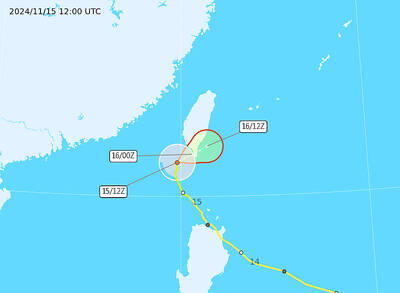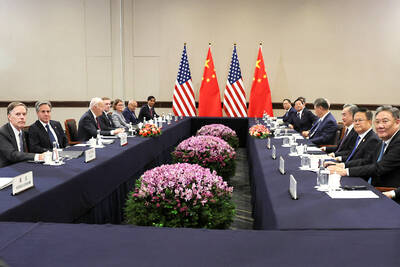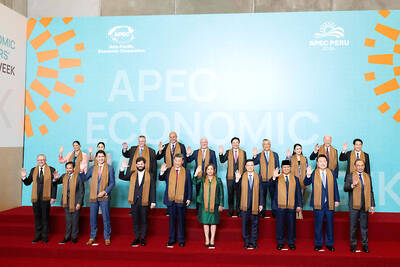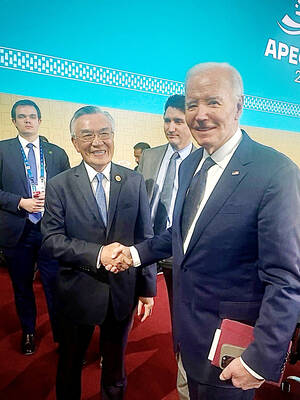Following a media report saying Formosat-5 was transmitting fuzzy images, National Space Organization (NSPO) officials yesterday said they are recalibrating the satellite’s camera, but denied that it had experienced a system failure.
Formosat-5, the nation’s first domestically developed satellite, which cost about NT$5.65 billion (US$187.5 million), was launched on Aug. 25 from Vandenberg Air Force Base in California. It was scheduled to start sending images to the NSPO by Sept. 8.
A report published yesterday by the Chinese-language Liberty Times (the Taipei Times’ sister paper) said the imaging capability of Formosat-5 might be compromised after the first set of images it sent back on Sept. 7 were blurry, with some showing stripes and light spots.

Photo: Chen Chih-chu, Taipei Times
The report also said the agency had detected the problem before the satellite’s launch, but failed to calibrate its CMOS chips.
The agency acknowledged that the images were not satisfactory.
The images appear to have only 8m resolution while the satellite should have provided color images down to 4m, National Applied Research Laboratories vice president and NSPO Acting Director-General Wu Kuang-chung (吳光鐘) said.
The focus problem is not caused by any defect in the satellite’s CMOS, Wu said.
One possible cause is vibrations during the satellite’s delivery or launch, but a more in-depth investigation is needed to reach a conclusion, he said, adding that the agency hopes to solve the problem in two or three months.
“NSPO did not observe any similar problems when it tested the satellite on land,” NSPO Deputy Director-General Yu Shiann-jen (余憲政) said.
The agency plans to modify the satellite’s focal length either by adjusting its internal temperature, altering its orbit altitude or improving resolution through image deconvolution software, Yu said, adding that changing its altitude would be riskier.
“We have to confirm whether the focal length is extended or shortened before deciding on which solution to adopt,” Yu said, declining reporters’ requests to provide a worst-case scenario if recalibration fails.
The remote sensing function is the last test of Formosat-5, while all other scientific payloads are functioning normally, Yu said.
“As I have always maintained, the real test of a satellite begins only after it is launched into space,” NSPO Formosat-5 project director Chang Ho-pen (張和本) said, reaffirming that previous tests were smooth.
Asked why the agency could not fix the problem one week after it was found, Chang said the satellite’s heating and cooling takes many steps.
The nation’s next satellite, Formosat-7, is scheduled to be launched next year.
The project is a collaboration between Taiwan and the US.
The problem of Formosat-5 will not affect the Formosat-7 project, which is tasked with a different mission — to gather space weather data, Yu said.

Typhoon Usagi yesterday had weakened into a tropical storm, but a land warning issued by the Central Weather Administration (CWA) was still in effect in four areas in southern Taiwan. As of 5pm yesterday, Tropical Storm Usagi was over waters 120km south-southwest of Oluanpi (鵝鑾鼻), the southernmost tip of Taiwan proper, and was moving north at 9kph, CWA data showed. The storm was expected to veer northeast later yesterday. It had maximum sustained winds of 101kph, with gusts of up to 126kph, the data showed. The CWA urged residents of Kaohsiung, Pingtung County, Taitung County and the Hengchun Peninsula (恆春) to remain alert to

ONE LAST TALK: While Xi said that Taiwan was a ‘red line,’ Biden, in what is likely his last meeting with Xi as president, called for an end to China’s military activity around Taiwan China’s military intimidation and economic coercion against Taiwan are the main causes of tensions that are destabilizing peace in the Taiwan Strait, Taipei said yesterday while thanking US President Joe Biden for expressing Washington’s firm stance of maintaining peace and stability in the region. Biden and Chinese President Xi Jinping (習近平) met on Saturday for their third meeting and their first talks in seven months on the sidelines of the APEC forum in Lima, Peru. It was likely Biden’s last meeting as president with Xi. During their conversation, Biden reiterated the US’ opposition to any unilateral change to the “status quo” from either

Taiwan would participate in the 2026 APEC summit to be hosted by China after Beijing promised it would ensure the personal safety of attendees, Taiwanese national security sources said yesterday. The APEC Leaders’ Machu Picchu Declaration announced yesterday said that China would host the APEC summit in 2026. Beijing proposed hosting the summit shortly before this year’s gathering began on Friday, a national security official said, speaking on condition of anonymity. Many APEC members expressed concerns about China hosting the event and said that prior communication over the decision was insufficient, the official said. Taiwan brought up concerns about legal “guidelines” China announced in

MEET AND GREET: The White House, which called the interaction ‘just a handshake,’ did not immediately respond to a request for comment on whether Biden planned to visit Taiwan’s envoy to the APEC summit, Lin Hsin-i (林信義), on Friday invited US President Joe Biden to visit Taiwan. During the APEC Leaders’ Informal Dialogue, Lin, who represented President William Lai (賴清德) at the summit, spoke with Biden and expressed gratitude to the outgoing US president for his contribution to improving bilateral ties between Taipei and Washington over the past four years, the Ministry of Foreign Affairs said. Lin and Biden exchanged views during the conversation, with Lin extending an invitation to Biden to visit Taiwan, it said. Biden is to step down in January next year, when US president-elect Donald Trump is